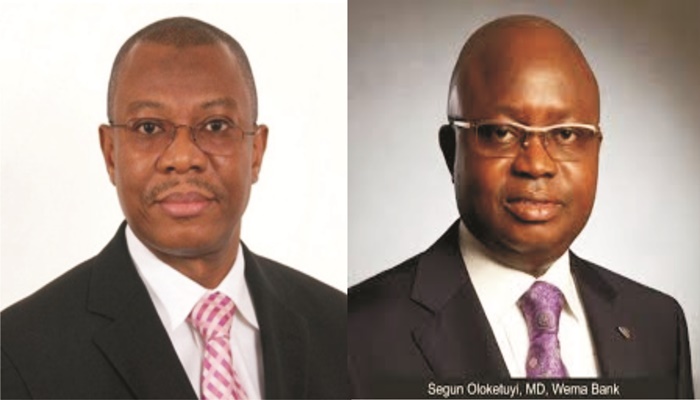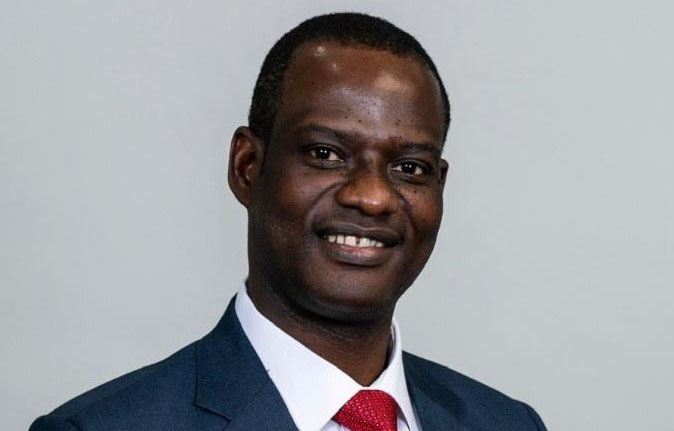
Niyi Olaoye
The management of Wema Bank Plc and Sterling Bank Plc are both currently shopping for a replacement for their incumbent Group Managing Directors whose tenure both expire in June and December respectively, Bussiness247 Online News exclusively revealed.
It would be recalled that the Central Bank of Nigeria (CBN) in 2010, issued a circular that the MDs/CEOs of Nigerian banks shall no longer spend more than 10 years in office as part of efforts to sanitize the banking sector. One year after this circular, a number of banks namely Zenith, UBA and Skye Banks lost their MDs/CEOs to this policy.
Mr Segun Oloketuyi, is currently the Managing Director/Chief Executive Officer of Wema Bank Plc. Until his appointment, he was an Executive Director, Skye Bank Plc with the responsibility for business development across Lagos and South-West directorates of the bank. While Mr. Yemi Adeola currently serves as the Managing Director/Chief Executive Officer of Sterling Bank Plc a role he has held since December 2007.
A source close to Wema Bank Plc, however, revealed that the Board of Directors of the bank has, therefore, appointed Ademola Adebisi as the Deputy Managing Director of the bank, which could be acting in capacity of the MD prior to his unveiling as the next MD of the bank.
Though as Deputy Managing Director, Wema Bank said Adebise will still oversee the bank’s Corporate and Business Directorate, covering corporate banking, treasury and financial institution, south business group (South-South and South-East) and business support division, but according to the source within the bank, Oloketuyi has been granted leave, allowing Adebisi to be acting as the MD of the bank.
Prior to this appointment, Bussiness247 Online News notes that Adebise was the Executive Director in charge of the bank’s Corporate & South Directorate. He has over 28 years’ experience in the banking industry (including four years in management consulting), working in diverse areas such as information technology, financial control & strategic planning, treasury, corporate banking, risk management and performance management.
Wema Bank’s financials
However, Wema Bank which celebrated its 71st anniversary in May last year, published its 2016 half year financials as 11 per cent rise in profit and a 15 per cent rise in turnover.
The bank delivered an interest income of N20.2 billion, a 15 per cent increase from N17.5 billion in the first half of 2015, while its fee and commission income also jumped by 42.3 per cent, from N2.2 billion in the first half of 2015 to N3.1 billion in the first half of 2016.
The bank also recorded a 13.7 per cent growth in total assets, from N344.64 billion in the first half of 2015 to N391 billion in the first half of 2016. Furthermore, its operating expenses grew marginally by 2.7 per cent.
Wema Bank on the Growth Trajectory
“Six years ago, we took a decision to refocus the bank’s operations on its areas of strength and build a sustainable institution. We took advantage of the new licensing regime and applied for a regional authorisation with a pledge to expand in the near future, once the turnaround project was completed.
“The bank’s transformation was implemented in three phases -first to stabilise the bank, second to prepare the building blocks for growth and third to go for growth. We are now within the third phase of the transformation project,” Oloketuyi explained.
He added: “The 2016 financial year has been characterised by deceleration on a number of economic indicators coupled with increasing energy costs, intensified by rising inflation, all within a tough operating environment.
Wema Bank’s Capital Raising
The bank recently raised N50 billion tier-2 capital, by issuing a bond. The first tranche was N20 billion and the second tranche was N30 billion.
“In recapitalizing an institution, what you need to watch out is your optimum capital. Sometimes, if you make it all tier-1, it may not just be the optimal that you need. So, sometimes you also need to have some dose of tier-2.
“In 2009 when we took over, we had a distressed institution and all indices pointed to that direction. As at December 2009, the audited financial statement showed a negative capital of N45 million and the bank was totally on its knees. The share of market we had then was less 0.6 per cent. Equipment and processes and the platforms we were running were obsolete and the core banking application we had which is the platform we use to serve our customers, was old to the level that it couldn’t be supported by those who supported them.
“The non-performing loan ratio was 89 per cent and the performance of the bank was poor. So, we came in and said we need to have a containment strategy to stop the bleeding and stabilise the bank. So, between 2010 and 2014, was largely to give life back to the bank.
“A distressed bank needs to be turned around to a performing bank. Of course, you need capital for any business, more so for banking which is a regulated business. So, the first major assignment we did was to recapitalise the bank. Today we have been able to completely turn around the bank,” Oloketuyi explained.
Sterling Bank and its Succession Plan
Meanwhile, nothing is yet to be heard of Sterling Bank Plc succession plan as the bank is also said to be searchig for the next MD of the bank with also an opening hand to merger and acquisition.
It will be recalled that the Managing Director/Chief Executive Officer of Sterling Bank Mr. Adeyemi Razack Adeola had sometime last year said that the bank was likely to experience merger and acquisition in 2016.
He said: “I think if opportunities arise for banks to pursue further consolidation, we could see two or three. I also know that two or three international banks are interested in pursuing acquisition in Nigeria and they are indeed having discussions already.
“So you could see combination of one or two international banks taking over one or two Nigerian banks or merging with them. Nothing also stops two, three banks from having merger discussions in 2016 from the look of thing,” he added.
Sterling Bank’s Financials
Sterling Bank was formed ten years ago following the merger of five legacy financial institutions namely Magnum Trust Bank; Indo Nigeria Bank; Trust Bank of Africa; MBM Merchant Bank and NAL Merchant Bank. Listing the achievement of the bank in its ten years of existence, Adeola said that the Total Assets of the bank has grown from N110 billion in 2006 to N1 trillion in 2015. He disclosed that the bank expanded its branch network by 135 from 50 in 2006 to 185 in 2015 said plans were on to ensure that the bank is ranked among the top six banks in the country by year 2020.
Besides, Adeola stated that the deposit liabilities of the bank grew from N75 billion in 2006 to N583 billion in 2015 while equity rose from N26 billion to N88 billion.
Similarly, its customer base rose from 200,000 in 2006 to 1.4 million in 2015. Adeola who was supported by the Executive Director, Corporate & Investment Banking, Mr. Kayode Lawal and the Executive Director/Chief Operating Officer, Mr. Yemi Odubiyi also explained that the Bank, within ten years had deployed 801 ATMs nationwide when it had none in 2006.
Speaking on the major activities of the Bank in the current year, the Bank’s Chief Executive said that “the outgoing year has been a beehive of activities and we have good reason to celebrate.
The Bank was involved in a lot of activities that added value not only to our customers but with great impact on all Nigerians”.
Some of the major activities of the bank according to Adeola included the organization of the first Sterling MSME Academy to enhance the capacity of Micro, Small and Medium Enterprises; the financing of the acquisition of 434 BRT buses by the Lagos State Ministry of Transport to improve the transportation system in Lagos State; the financing of Labana Rice Processing Mills in Kebbi to support the diversification programme of the Federal Government; the execution of an e-library project at the College of Education, Ikere Ekiti to support the education sector and the execution of two editions of the periodic cleaning exercise to support a clean environment across the country.
During this period, the Chief Executive Officer stated that the Bank was PCIDSS 3.0 re-certified, making it the third bank to achieve this status in the country. The financial institution also procured a Visa principal status, which affords it the ability to issue cards and acquire merchants directly. Other notable feats included a successful integration of its mobile wallet to the NIBSS Instant Pay platform which allows unbanked and semi unbanked customers to perform inter-bank transfers on Sterling Money; 13 additional branches were also opened and eight branches re-modelled.
He however disclosed that all the contributions of the Bank did not go unnoticed as it won the Most Innovative Bank and Best Corporate Governance awards in the West Africa Awards organized by The Banker Africa 2015; Best Bank Website of the year award by the Nigeria Technology Awards and emerged as a finalist- Best New Product/Service Recognition for Disruptive Technology/Innovation for Social Lender at the EFMA/Accenture Distribution and Marketing Innovation Awards 2015.
Adeola assured that before he leaves, the Bank will sustain its drive to become the leading consumer banking franchise, diversify its retail funding base, diversify its income streams with a view to achieving a top quartile position in all “our operating areas and enjoy a double digit revenue growth year on year”, he stated.






